Honda Civic Service Manual: Rear Brake Disc Inspection


Frequent inhalation of brake pad dust, regardless of material composition, could
be hazardous to your health.
|

|
Avoid breathing dust particles.
|
|
|

|
Never use an air hose or brush to clean brake assemblies. Use
an OSHA-approved vacuum cleaner.
|
|
|
|
1.
|
Raise the vehicle on a lift, and make sure it is securely supported.
|
|
|
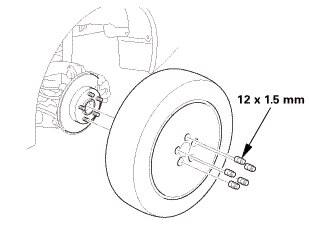
|
|
1.
|
Remove both rear wheels.
|
|
|
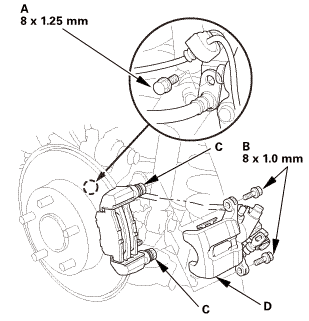
|
|
1.
|
Remove the brake hose mounting bolt (A).
|
|
2.
|
Remove the flange bolts (B) while holding the respective caliper
pins (C) with a wrench.
|
|
3.
|
Remove the caliper body (D).
|
|
NOTE: Do not twist the brake hose and the parking brake cable
to prevent damage.
|
|
4.
|
Check the hose and pin boots for damage and deterioration.
|
|
|
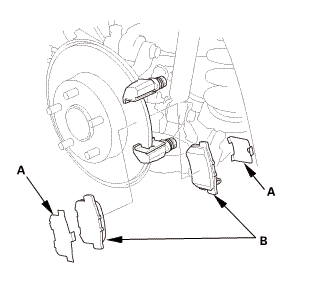
|
|
5.
|
Remove the pad shims (A) and the brake pads (B).
|
|

| 1. |
Rear Brake Disc Thickness and Parallelism - Inspection |
|
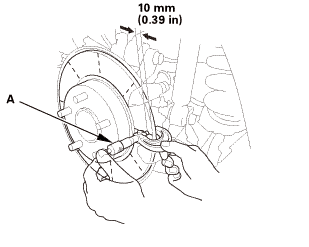
|
|
1.
|
Using a micrometer (A), measure the brake disc thickness at eight
points, about 45 ° apart and 10 mm (0.39 in) in from the outer edge
of the brake disc.
|
|
Replace the brake disc if the smallest measurement is less than
the maximum refinishing limit.
|
|
|
Brake disc thickness:
|
| |
Standard:
|
9.0 mm (0.354 in)
|
| |
Maximum refinishing limit:
|
8.0 mm (0.315 in)
|
|
Brake disc parallelism*:
|
0.015 mm (0.00059 in) max.
|
|
|
|
|
*: This is the maximum allowable difference between the thickness
measurements.
|
|
2.
|
If the brake disc is beyond the service limit for parallelism,
refinish the brake disc with a Honda-approved commercially available
on-car brake lathe.
|
|
NOTE: If the brake disc is beyond the service limit for refinishing,
replace it.
|
|
3.
|
Inspect the brake disc runout.
|
|
| 2. |
Rear Brake Disc Runout - Inspection |
|
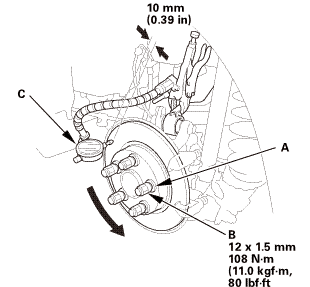
|
|
1.
|
Inspect the brake disc to wheel surface for damage and cracks.
|
|
2.
|
Clean the brake disc thoroughly, and remove all rust.
|
|
3.
|
Install suitable flat washers (A) and the wheel nuts (B).
|
|
4.
|
Tighten the wheel nuts to the specified torque to hold the brake
disc securely against the hub.
|
|
5.
|
Set up the dial gauge (C) against the brake disc as shown.
|
|
6.
|
Measure the runout at 10 mm (0.39 in) from the outer edge of
the brake disc.
|
|
|
Brake disc runout:
|
| |
Service limit:
|
0.04 mm (0.0016 in)
|
|
|
|
|
7.
|
If the brake disc is beyond the service limit, refinish the brake
disc with a Honda-approved commercially available on-car brake lathe.
|
|
Maximum refinishing limit: 8.0 mm (0.315 in)
|
|
NOTE:
|
|

|
If the brake disc is beyond the service limit
for refinishing, replace it.
|
|
|

|
If the brake disc is replaced with a new one,
check the new disc for runout. If the new disc is
out of specification, refinish the disc.
|
|
|
|


Frequent inhalation of brake pad dust, regardless of material composition, could
be hazardous to your health.
|

|
Avoid breathing dust particles.
|
|
|

|
Never use an air hose or brush to clean brake assemblies. Use
an OSHA-approved vacuum cleaner.
|
|
|
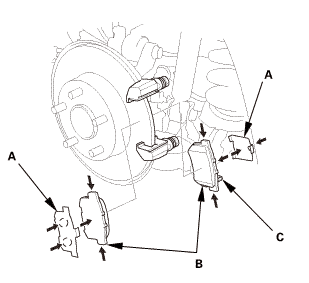
|
|
1.
|
Apply a thin coat of M-77 assembly paste (P/N 08798-9010) to
the pad side of the shims (A), the back of the brake pads (B), and
the other areas indicated by the arrows.
|
|
NOTE: Wipe off the excess assembly paste from the pad shims and
brake pads friction material.
|
|
2.
|
Install the brake pads and the pad shims.
|
|
NOTE: Install the brake pad with the wear indicator (C) on the
bottom inside position.
|
|
|
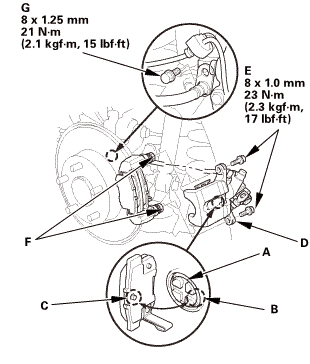
|
|
3.
|
Rotate the caliper piston (A) clockwise into the cylinder.
|
|
4.
|
Align the cutout (B) in the piston with the tab (C) on the inner
pad by turning the piston back.
|
|
NOTE: Be careful when moving the piston back in the caliper;
brake fluid might overflow from the master cylinder's reservoir.
If brake fluid gets on any painted surface, wash it off immediately
with water.
|
|
5.
|
Install the caliper body (D).
|
|
6.
|
Install the flange bolts (E) while holding respective caliper
pins (F) with a wrench.
|
|
7.
|
Install the brake hose mounting bolt (G).
|
|
8.
|
Press the brake pedal several times to make sure the brakes work.
|
|
NOTE: Engagement may require a greater pedal stroke immediately
after the brake pads have been replaced as a set. Several applications
of the brake pedal will restore the normal pedal stroke.
|
|
|
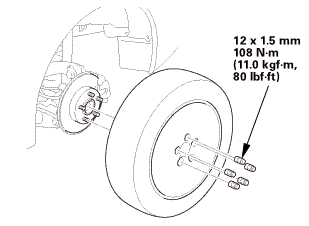 15mmumum 15mmumum
|
|
1.
|
Install both rear wheels.
|
|
NOTE: Before installing the wheel, clean the mating surfaces
between the brake disc or the brake drum and the inside of the wheel.
|
|














 15mmumum
15mmumum
